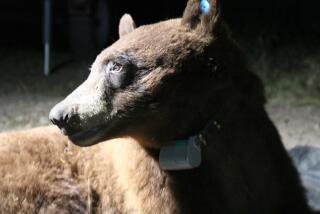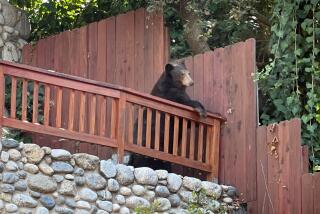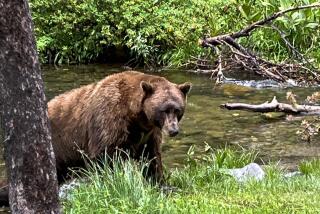Just the Naked Truth: Florida Bears Going Bald
- Share via
OCALA NATIONAL FOREST, Fla. — There is no hair club for bears. No nifty, bear-sized hair plugs. Not even a toupee.
All this is a darn shame -- the lumbering Florida black bears in this great expanse of pines and palmettos northwest of Orlando could use the help. In utter defiance of their bearish reputation for thick, bristly hairiness, the Ocala bears are going bald.
They aren’t just losing a few strands around the ears; some are dropping almost all their fur, leaving their skin raw and scarred as they forage for food in the tangled undergrowth.
“They look like aliens,” said Guy Marwick, a school museum curator who has lived next to the forest for decades.
Scientists and bear lovers are baffled. The strange, bald bears here are a mystery, yet another curiosity in a state renowned for its exotic creatures.
Nothing like this has ever happened before, puzzled veterinarians said. Sure, a stray balding bear or two has turned up in other parts of the country. But until the bald bears in the Ocala forest were discovered, no one had ever heard of a mass case of hairless bears, said Mark Cunningham, a veterinarian with the Florida Fish and Wildlife Conservation Commission.
Cunningham estimates that half of the Ocala’s 450 or so Florida black bears, which the state lists as a threatened subspecies, are losing their hair. The females are getting the worst of it, with more than 80% going bald.
The bald bears have been compared to giant rats or bizarre, outsize kangaroos. But Cunningham said they seem to be generally healthy, aside from the considerable annoyance and constant discomfort of mosquito bites and scratches that have damaged the skin of some bears so much they resemble burn victims.
But Cunningham is attached to these bears anyway. He has helped as the state tries to figure out ways -- such as tunnels or overpasses -- to keep them from getting killed as they cross highways. He’s become emotional about orphaned cubs.
So, there is no way that Cunningham could think of the Ocala’s bald bears as ugly. Neither, it seems, do the other bears. Even the most scarred among them appear to be mating normally.
The males, which typically weigh as much as 425 pounds, are handling the problem better than the more svelte females, who seldom top 250 pounds. Almost all black bears in the western edge of the Ocala have lost hair in the first year of their lives. But the problem appears to go away for most males in their second year, while it persists into adulthood for most females.
Unraveling the mystery of the bald bears has proved to be tricky. Cunningham doesn’t have unlimited resources, so he turned to a higher power: Disney.
Researchers at Disney’s Animal Kingdom are examining skin samples from bald bears trapped by Cunningham and from bears killed on the roads that bisect the Ocala. The University of Florida is working on the puzzle too.
The first step was easy enough. It didn’t take much for Cunningham and the others to figure out that the bald bears were suffering from mange, an affliction that sometimes strikes domestic dogs.
The mange is caused by a naturally occurring mite -- Demodex ursi -- that lives in hair follicles and feeds off dead skin.
But here’s where the mystery comes in: All bears have the mites. Usually, they get along just fine. The mites, content to ride along as harmless parasites, don’t bother the bears.
But something different is happening in the Ocala, where the number of bald bears has spiked in recent years, a decade after the first case of bear baldness was spotted here. The mite populations living off the bears here have gone wild, multiplying into the millions on some individual bears, Cunningham said.
“I’m fascinated by it,” Cunningham said.
Cunningham is chewing on all kinds of theories. He has thought about the possibility that the bears’ immune systems might have been weakened, preventing them from fighting off the mites. He has considered inbreeding, but he hasn’t found any evidence of that. He has also pondered the effects of some unknown toxin or pollution.
But he hasn’t been able to prove anything.
Marwick, who knows a thing or two about wildlife in the Ocala, plays the game too. He has noticed more bears poking around in his yard over the last couple of years and reasons that they may have expanded their foraging territory because of the drought. Maybe the change in feeding grounds has something to do with the balding problem, he said.
Marwick and a neighbor, his lifelong friend Twyman Cauthern, know the bears so well that they recognize them at a glance. There’s a cautious female who shows up in their yards many nights and there’s a big black male who shuffles awkwardly, probably the result of a hip injury.
“That big male, he’s a ham,” Cauthern said, flipping through a stack of mangy bear photos. “He stands right up on his hind legs -- it’s like he’s putting on a show.”
Marwick, a self-described tree hugger who tends to fixate on the problems of the forest, often tromps around the soggy meadow and the forest behind his house looking for clues. Pairs of sandhill cranes, graceful birds that mate for life, swooped and trumpeted above as he waded one recent afternoon through a meadow where tannins from rotting leaves turn the water the color of barrel-aged bourbon.
Marwick scanned for the hardly distinguishable paths in the undergrowth as he picked through the marsh.
“Bear path,” he said after spotting some broken branches tunneling into the forest.
Now Marwick is crawling through the bear’s path. There are long strands of cat’s claw vines dangling from the trees and draped across the white sand that distinguishes this forest, the world’s largest continuous scrub pine ecosystem. Surely the vines must be raking the poor bears’ backs unmercifully, Marwick said.
He dreams about transplanting some bear hair onto their unprotected backs, but finally concludes “it’s hard to get them to sit still to weave it.”
More to Read
Sign up for Essential California
The most important California stories and recommendations in your inbox every morning.
You may occasionally receive promotional content from the Los Angeles Times.










